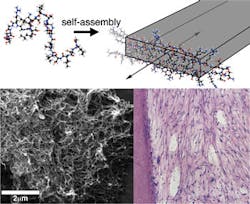Smart scaffolding aims to rebuild dental tissue from the inside
November 13, 2012
(Nanowerk News) Scientists at Rice and the Texas A&M Health Science Center Baylor College of Dentistry received a $1.7 million, five-year grant from the National Institutes of Health (NIH) to develop a hydrogel that can be injected into a patient to form an active biological scaffold.
Rice bioengineer Jeffrey Hartgerink and co-investigator Rena D'Souza of Baylor won the grant to continue their groundbreaking work on self-assembling, multidomain peptide hydrogels that not only physically support but also encourage the growth of specific kinds of tissues.
At top, graphic shows multidomain peptide self-assembling into a nanofiber. The scanning electron microscope image at bottom left shows formed nanofibers; at bottom right, a histological section of cells (blue dots) grows in a dentin cylinder, where they mimic the desired dental-pulp regeneration. Graphic courtesy of Hartgerink Group.
To learn more, read the full article from Nanowerk News.

